30 Stats That Explain Why Organizations Are Turning to Staff Augmentation for Fulfilling IT Hiring Needs
Table of Contents
The tech talent landscape has reached a breaking point due to traditional approaches. Only 30% of qualified professionals are available to fill the top technical roles, including AI, cybersecurity, and cloud engineering.
Along with this, World Economic Forum data shows 63% of organizations struggling to fill these critical roles. This shows that traditional hiring methods are no longer practical to meet the demand. But what’s the solution?
This blog reveals data-driven insights highlighting how traditional hiring is not enough to cater to the demand of today’s competitive business. It also covers how you, as a forward-thinking decision maker, can bridge this gap.
Talent scarcity statistics
Global tech talent shortage
- 70% of the talent shortage in the USA is for the top 5 technical skills, including IT & data, engineering, and sales & marketing. [ManpowerGroup]
- The biggest challenge to fill cybersecurity positions is that there is a 64% lack of qualified candidates, highlighting a high demand for these positions. [Boston Consulting Group]
- 63% of organizations face skill gaps when hiring for key roles such as AI & ML specialists and cybersecurity experts. [World Economic Forum]
- By 2030, more than 85 million tech talent shortage is expected due to not enough skilled people. [Korn Ferry]
- 48% of CIOs say their top barrier for skilled tech talent is a lack of HR capacity. [Gartner]
- The average life cycle of a tech skill is now only two and a half years. [Harvard Business Review]
Shortage of specialized skills
- Demand for AI/ML talent grew in previous years, but the supply of talent is not enough. [The Burning Glass Institute]
- Only 50% of the graduates have advanced digital skills for cloud and AI/ML roles. [AWS Global Digital Skills Study]
- More than 26% of cybersecurity job postings go unfilled in the USA, showcasing a significant talent gap in the U.S. states. [Cyber Seek]
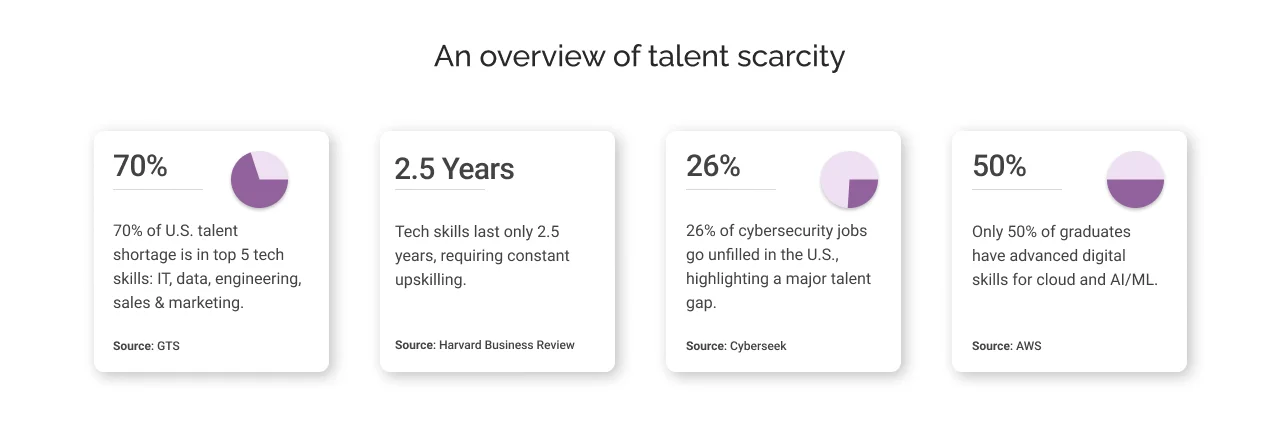
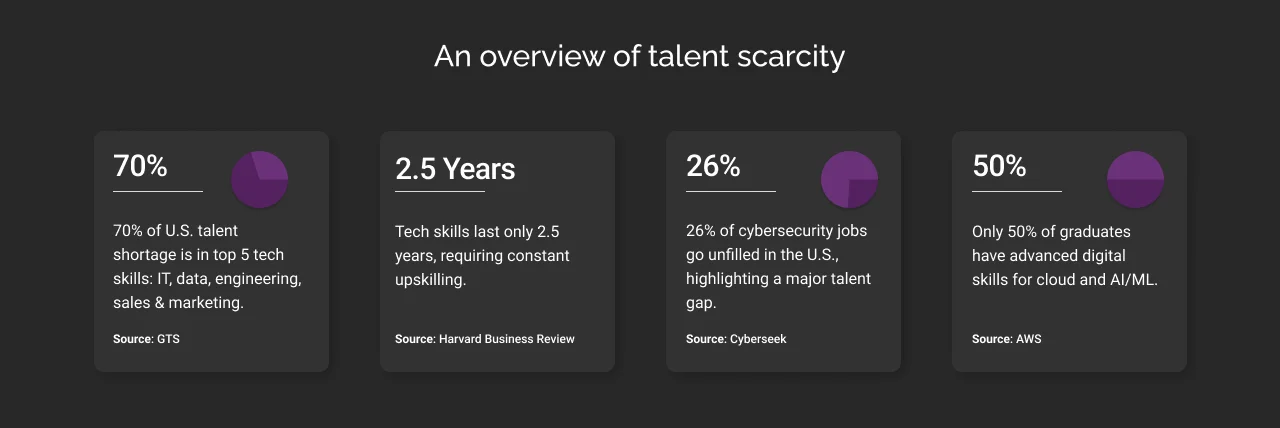
These stats explain why companies are actively tapping IT staff augmentation providers to fulfill IT roles. It allows them to navigate talent scarcity/skill gap and gives access to pre-vetted professionals that can be onboarded within 48 hours or less (in some circumstances).
For instance, if your Salesforce implementation project requires specialized expertise, like that of any particular product (e.g. Agentforce) or in any particular industry (e.g. financial services), hiring such a resource could take weeks. With IT staff augmentation, you can hire Salesforce developers with this required experience almost instantly, ensuring your project moves forward without any delays.
Statistics that signal rise in time-to-fill positions
- An average time to hire IT professionals in the USA is 35 days, indicating that if you need to fill a role urgently, the traditional hiring process fails. [SmartRecruiters]
- The average time to fill tech roles is between 40-45 days. [SHRM]
- While the time to fill specifically in the USA is 56 days but it takes around 70.5 days to hire a senior tech specialist (e.g., senior data scientists). [Workable]
- Around 1/3 of organizations required 4-6 months to fill a technical role in 2024. [Statista]
- An average time to fill a Salesforce developer role is around 50 days. [Dice]




Statistics that signal rise in average cost per hire
- The average cost per IT hire in the US is $4,683, and the executive cost per hire is $28,329, including recruitment, interview, and onboarding. [SHRM]
- The average recruitment fees range from 15%-20% of the tech employees’ first-year salary.
- The average replacement cost of an employee is equivalent to six to nine months of an employee’s salary. [SHRM]
- The replacement of tech leaders and managers costs around 200% of their salary, while the professionals in technical roles cost 80%. [Gallup]


These stats reveal how traditional hiring is not only time-consuming but also financially draining. From high recruitment fees to steep replacement costs, organizations are spending a significantly on securing/replacing tech talent. This escalating financial burden calls for a hybrid approach – traditional hiring for building a long-term workforce along with staff augmentation for skill gaps and project-based needs.
Employee turnover/poaching/retention statistics
- Replacing a tech employee costs employers a significant 6-9 months of the employee’s salary. [SHRM]
- 74% of poached tech talent goes to competitors offering remote/hybrid work and better compensation. [ISACA]
- 30% of new tech workers left their jobs within 90 days of starting. [Jobvite]
- Around 42% of employee turnover is preventable but often ignored by the management. [Gallup]
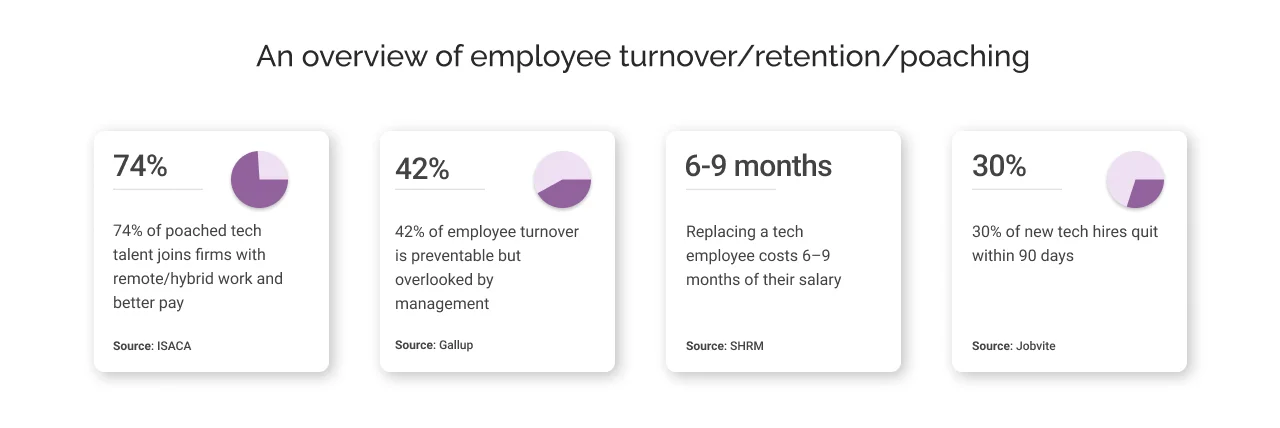
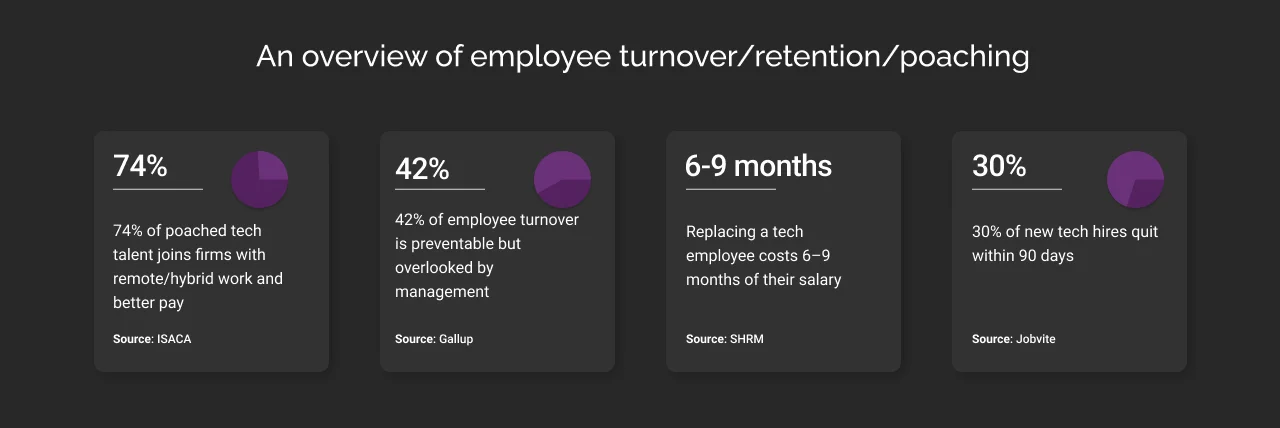
These stats highlight how fragile tech talent retention has become. With high turnover, poaching, and replacement costs, organizations are constantly at risk of losing critical expertise. Traditional hiring alone cannot keep pace with such volatility. Staff augmentation offers a safeguard – giving organizations flexibility to scale resources as employee churn continues to challenge it’s long-term stability.
Statistics that signal shift in employee preferences
- As we already stated in the employee retention section, every 3 out of 4 tech talent switch their jobs with a remote/hybrid work offering company. [ISACA]
- Around 38% employees prefer a hybrid and fully remote working environment, and are predicted to go up to 40% in 2028. [Centre For Economic Policy Research (CEPR)]
- Around 50% of freelance/augmented workers are providing skilled work for IT-related tasks (programming, Salesforce consulting, etc.) (UpWork)
- Administration, application development, web hosting, and other IT-related tasks are the biggest areas of outsourcing. [Statista]
- Around 300,000 jobs in the USA have been outsourced by organizations for cost-effective budget reasons. [Zippia]
- Remote working led to a 13% performance improvement, and employees reported work satisfaction as well. [Stanford]
- Nearly half of the tech talent prefer hybrid job roles for switching, while 26% of employees would prefer a fully remote role. [Robert Half]
- 59% of businesses outsource tech talent for cost efficiency. [Zippia]
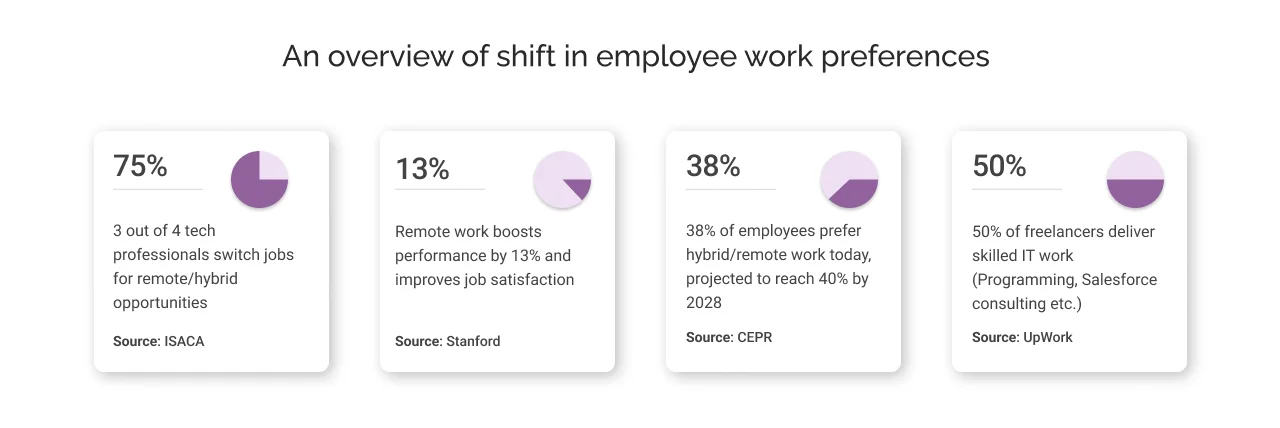
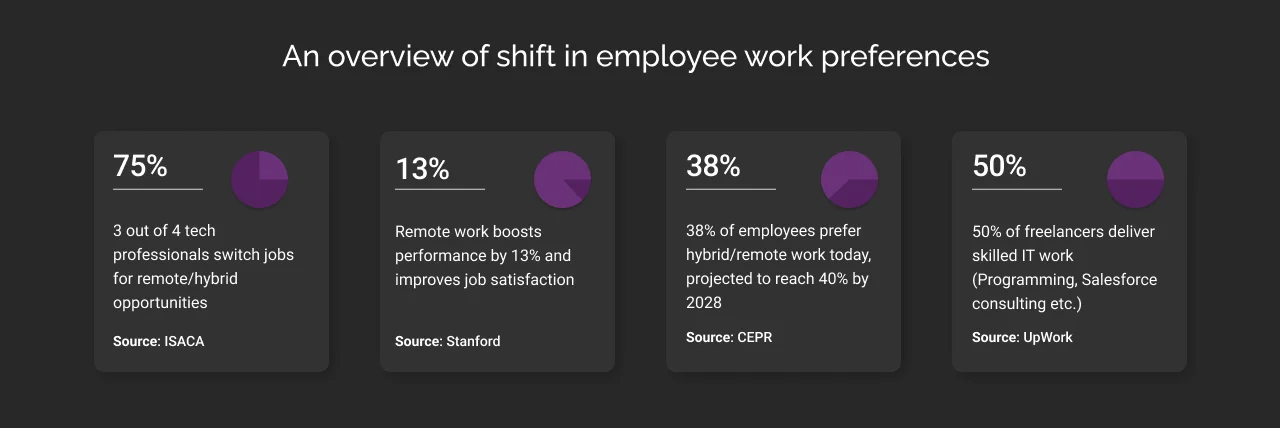
With most tech professionals preferring remote/hybrid work, and a significant portion of IT tasks already outsourced, organizations must adapt or risk losing talent to competitors. Staff augmentation directly aligns with this shift – it enables organizations to tap into global talent pools without being limited by traditional employment constraints.
The strategic shift: A hybrid talent model for the modern enterprise needs
This evidence is undeniable; you can see that traditional hiring alone is no longer viable for maintaining a competitive edge. However, this does not mean you have to abandon it entirely, but the solution is to augment staff intelligently.
As a forward-thinking leader, adopting a hybrid talent model approach can provide the stability of a core internal team for long-term vision and the agility of staff augmentation for specialized skills and scaling needs.
How is IT staff augmentation leading the charge? IT staff augmentation emerges as the key that unlocks this hybrid model, allowing you to:
- Bridges the gap of talent with pre-vetted specialists.
- Eliminate employee turnover risk through flexible engagements.
- Tap into a global talent pool remotely.
- Accelerate time to market with the required staff augmentation.
In 2026 and the coming years, businesses, including startups with the smartest staffing strategies, can easily win and dominate.
Now, the question is not whether you can afford IT staff augmentation, but whether you can afford not to adopt it.
We at Cyntexa offer IT staff augmentation services at transparent pricing with a global talent pool. You can deploy pre-vetted experts matching your requirements in days, not in months, and build the agile team you need to succeed.
Schedule a consultation call today!
Don’t Worry, We Got You Covered!
Get The Expert curated eGuide straight to your inbox and get going with the Salesforce Excellence.
AUTHOR
Tanushri
Head of Growth And Strategy
Tanushri heads Growth and Strategy at Cyntexa, with over 6 years of experience in sales and marketing. She specializes in aligning go-to-market teams, scaling revenue operations, and building structured, tech-enabled growth plans. Tanushri also advises businesses on Salesforce, ServiceNow, AWS and Google Cloud adoption, ensuring each strategy is execution-ready, future-proof, and tailored to the organization’s maturity and growth goals.


Cyntexa.
Join Our Newsletter. Get Your Daily Dose Of Search Know-How






